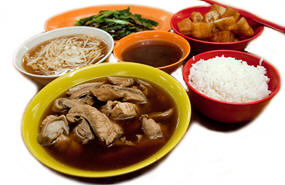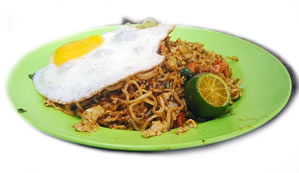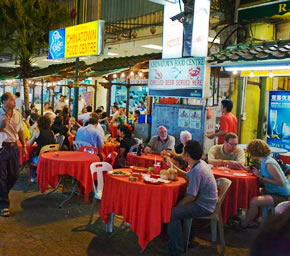Kuala Lumpur ~ Food
KL Visitors Guide
HOME >
VISITORS
GUIDE > KL INSIGHTS >
FOOD
When you descend upon
KL, the one thing you must not miss out on is the FOOD. Get yourself
involved in our favourite pastime : Malaysians love to eat and we eat ALL
the time. With our multi-cultural social mix, you certainly can expect
somewhat of a unique and endless blend of cuisine.

As far as the budget is
concerned, you can eat fairly well for fairly little in KL. Just head to the
roadside stalls, especially noted are those in Chinatown in the City Centre
and Jalan Alor in the Golden Triangle. Though mostly open only at night,
have some of the greatest concentration food stalls. Most shopping malls
also provide food-courts that allows you to sample Malaysian food in more
hygienic conditions.
What to Eat
Primarily consisting of Malay, Chinese and Indian food, it also has its
hybrids derived from cross cultural influences such as Mamak (Indian-Muslim)
and Nyonya (the Malay-Chinese mix). Of course you also have western,
Mediterranean and Arab restaurants as well to choose from. There are also
vegetarian food available in Indian and some specialised Chinese restaurants.
Malay Food
The dishes are "Halal" (kosher) and have their distinctive spicy flavor; Chili, lemon grass, Pandan (screwpine)
leaves, daun kesum (polygonum or laksa leaf), kunyit (tumerc), bunga kantan
(wild ginger buds) are some of the spices used. There are many but some
popular dishes include -

Nasi Lemak ~ literally means 'rice in fat' in Malay, the name is derived
from the cooking process whereby rice is soaked in rich coconut cream and
then the mixture steamed. Sometimes knotted screwpine (pandan) leaves are
thrown into the rice while steaming to give it more fragrance.
Popularly eaten for breakfast
among the locals, this dish consists comes as a platter with cucumber
slices, ikan bilis (fried anchovies in hot chilli paste), roasted peanuts,
stir fried water convolvulus (kangkong), hard boiled egg, slices of boiled
egg and cucumber, larger
 portions can include chicken, beef or squid.
Traditionally most of these accompaniments are spicy in nature.
portions can include chicken, beef or squid.
Traditionally most of these accompaniments are spicy in nature.
Ikan Bakar ~ literally means "burnt fish" in Malay, its is fish or other
forms of seafood grilled using charcoal. Usually, marinated and then
grilled; sometimes with a banana leaf between the seafood and hotplate.
Some
of the popular forms of seafood besides fish include squid (sotong) and
stingray.

Nasi Goreng Pattaya / Nasi Pattaya ~ Made by covering or wrapping chicken
fried rice, in fried egg. It is often served with chili sauce, cucumber. The
name comes from Pattaya, Thailand.
Satay ~ Marinated beef or chicken pieces in skewers are barbecued over
charcoal and eaten after dipping into a sweet and spicy peanut sauce. It can
also be served with ketupat (rice cubes wrapped in palm leaves) and cucumber.
Chinese Food
The variety of local Chinese food stems from the different parts of China
from which the early immigrants originated. Although Influenced by local
ingredients and dishes from other cultures, it remains distinctly Chinese.
Most Chinese meals have pork as their sub-ingredient, but due to the
popularity and unique taste of the actual food, there are chicken options
available for the local Malays (most Malays are Muslims, and Islam forbids
them from eating pork).
Some Chinese food restaurants nowadays can be found
serving 'halal' or kosher food i.e. food without ingredients that are
forbidden by the Islamic religion. Outlined below are some of the one person
dishes that can be obtained -

Hainanese Chicken Rice ~ Rice cooked in chicken stock and topped with
steamed or roasted chicken.

Wantan Mee ~ Soup noodles with prawn or pork dumplings and thin slices of
roast pork or minced chicken.
Assam Laksa ~ A special from
Penang consisting of thick rice Char Kuey Teownoodles in a spicy and sour
fish-based soup with pineapple, cucumber and onions. A sweet, thick prawn
paste may be added for extra flavor.

Char Kuey Teow ~ Stir fried flat rice noodles with prawns, cockles, egg and
bean sprouts
Dim Sum ~ Delicate morsels of specialties with over 30 varieties served in
round bamboo baskets. Includes steamed prawn dumplings.

Bak Kut Teh ~ The name literally translates as "pork bone tea", is a Chinese
soup that consists of a complex broth of herbs and spices (including star
anise, cinnamon, cloves, dang gui and garlic), boiled together with pork
bones for hours.
However, additional ingredients may include offal,
varieties of mushroom, lettuce, and pieces of dried tofu. Light and dark soy
sauce are also added to the soup during cooking, with varying amounts
depending on the variant. It is usually eaten with rice, and often served
with youtiao (strips of fried dough) for dipping into the soup.
More
on Chinese Noodles and Dim Sum.

Indian Food
Local Indian cuisine can be divided into Northern Indian, Southern Indian
and Indian-Muslim (or Mamak) Cuisine. Northern Indian dishes are mostly meat
based and cooked with yogurt and ghee. Southern Indian cooking contains a
liberal dose of coconut, tamarind and curry leaves while Indian-Muslim
cuisine features rice and vegetables with rich, thick curries.
Northern Indian Food
Roti Chanai ~ A local favorite, this pancake is made out of wheat flour
dough which is stretched, layered and fried on a griddle. Variations include
Roti Telur where Roti Chanaiegg is added, while Roti Sardin is filled with
sardines. It should be fluffy and not hard and is delicious when eaten with
the milder 'Dhall or with spicy meat curries or even plain
with sugar.

Chapatti ~ Flattened bread made from whole-wheat flour and enjoyed with any
curry or served with Potato Masala, a chunk of mashed potatoes with
vegetables.
Naan ~ A healthier option, looking somewhat like a plain pizza, this fluffy and thick bread is baked on the
'tandoori', a traditional clay oven
Tandoori Chicken ~ The chicken is marinated in a yogurt seasoned with
tandoori masala. It is traditionally moderately spicy. Cayenne, red chili
powder, or other spices give it its red colour. It is traditionally cooked
at high temperatures in an earthen oven (tandoori), but can also be prepared
on a traditional grill.
Southern Indian Food
Cooking contains a liberal dose of coconut, tamarind and curry leaves.
 Banana Leaf Rice ~ Rice served on a banana leaf (the first
disposable eco friendly plates), with an assortment of vegetables, curried
meat or fish, pickles, and/or 'papadum'.
Banana Leaf Rice ~ Rice served on a banana leaf (the first
disposable eco friendly plates), with an assortment of vegetables, curried
meat or fish, pickles, and/or 'papadum'.
It is traditionally eaten with the
hand. Hands are washed before and the right hand is used during the meal.
The banana leaf is used as it is believed that the hot rice will release the
coating on the banana leaf, which aids in digestion.
 Thosai ~ Also spelled as 'dosai', is a batter made from lentils and rice blended with water and left to
ferment overnight. The batter is spread into a thin, circular disc on a
flat, preheated pan, where it is fried with a dash of edible oil or ghee
until the 'dosai' reaches a golden brown colour.
Thosai ~ Also spelled as 'dosai', is a batter made from lentils and rice blended with water and left to
ferment overnight. The batter is spread into a thin, circular disc on a
flat, preheated pan, where it is fried with a dash of edible oil or ghee
until the 'dosai' reaches a golden brown colour.
Then the 'thosai' may optionally
be turned over on the pan, and partially fried. The end product is neatly
folded and served.
Having a slightly sourish taste, it is served with
'dhall'
(vegetable curry), coconut chutney or curry, There is a thinner, crispier
version called simply, 'paper tosai'.
Idli (pronounced Itly) ~ Made from lentils (specifically black lentils) and
rice into patties, usually two to three inches in diameter, using a mold
and steamed. Most often eaten at breakfast or as a snack, idli are usually
served in pairs with chutney, dhall, or other accompaniments.
Briyani ~ a well known rice dish from the made from a mixture of spices, basmati rice,
meat/vegetables and yogurt. The ingredients are ideally cooked together in
the final phase and is time-consuming to prepare.
Mamak or Indian Muslim Food
Nasi Kandar ~ White rice or
briyani rice served with other dishes of curry either with chicken, fish,
beef, or mutton and usually with pickled vegetables and
Teh Tarik.
 Maggi
Goreng ~ A dish of fried Maggi instant noodles with flavoring (usually
curry), vegetables, egg, tofu and occasionally chicken.
Maggi
Goreng ~ A dish of fried Maggi instant noodles with flavoring (usually
curry), vegetables, egg, tofu and occasionally chicken.
Mamak Rojak ~ Contains fried dough fritters, bean curds, boiled potatoes,
prawn fritters, hard boiled eggs, bean sprouts and cucumber mixed with a
thick, spicy peanut sauce.
 Teh Tarik ~ Tea sweetened using condensed milk, and prepared using
out-stretched hands to pour piping hot tea from a mug into a waiting glass,
repetitively.
Teh Tarik ~ Tea sweetened using condensed milk, and prepared using
out-stretched hands to pour piping hot tea from a mug into a waiting glass,
repetitively.
The higher the 'pull', the thicker the froth. The 'pulling' of
tea also has the effect of cooling down the tea.
A well-loved drink amongst
Malaysians, teh tarik is a form of art in itself and watching the tea
streaming back and forth into the containers can be quite captivating.
Where to Eat
 KL has a good number of restaurants, some of them offering better food than
others.
KL has a good number of restaurants, some of them offering better food than
others.
The Golden Triangle, Bangsar and Midvalley, Heritage Row and some
areas in Damansara and Hartamas are the usual places for visitors for
a restaurant meal.
In terms of ethnicity, Chinatown and Jalan Alor (near Bukit Bintang) is the best place to search for Chinese
food, although all kinds of Chinese cuisine, from the simplest to the most
sophisticated, can be found all over KL.
For Indian Food, head to Lebuh Ampang in the City
Centre and Brickfields.
Malay food can be found in Jalan
Masjid India, Chow Kit and Kampung Baru areas in the Tuanku Abdul Rahman
district.
Bangsar, as well as Changkat
Bukit Bintang has many cafe's and high-end restaurants offering Western food. If
you are dying for Korean food, head to Ampang Jaya.
A lot of European, oriental and Middle Eastern restaurants have mushroomed
especially in Bukit Bintang and the Golden Triangle Area.
 K. LUMPUR ~ INSIGHTS
K. LUMPUR ~ INSIGHTS
BRIEF HISTORY
PEOPLE & CULTURE
SHOPPING
FOOD
TRANSPORT
NETWORK
SAFETY GUIDE
KL NIGHTLIFE
EVENTS




 portions can include chicken, beef or squid.
Traditionally most of these accompaniments are spicy in nature.
portions can include chicken, beef or squid.
Traditionally most of these accompaniments are spicy in nature.






 Banana Leaf Rice ~ Rice served on a banana leaf (the first
disposable eco friendly plates), with an assortment of vegetables, curried
meat or fish, pickles, and/or 'papadum'.
Banana Leaf Rice ~ Rice served on a banana leaf (the first
disposable eco friendly plates), with an assortment of vegetables, curried
meat or fish, pickles, and/or 'papadum'.  Thosai ~ Also spelled as 'dosai', is a batter made from lentils and rice blended with water and left to
ferment overnight. The batter is spread into a thin, circular disc on a
flat, preheated pan, where it is fried with a dash of edible oil or ghee
until the 'dosai' reaches a golden brown colour.
Thosai ~ Also spelled as 'dosai', is a batter made from lentils and rice blended with water and left to
ferment overnight. The batter is spread into a thin, circular disc on a
flat, preheated pan, where it is fried with a dash of edible oil or ghee
until the 'dosai' reaches a golden brown colour.  Maggi
Goreng ~ A dish of fried Maggi instant noodles with flavoring (usually
curry), vegetables, egg, tofu and occasionally chicken.
Maggi
Goreng ~ A dish of fried Maggi instant noodles with flavoring (usually
curry), vegetables, egg, tofu and occasionally chicken. Teh Tarik ~ Tea sweetened using condensed milk, and prepared using
out-stretched hands to pour piping hot tea from a mug into a waiting glass,
repetitively.
Teh Tarik ~ Tea sweetened using condensed milk, and prepared using
out-stretched hands to pour piping hot tea from a mug into a waiting glass,
repetitively.  KL has a good number of restaurants, some of them offering better food than
others.
KL has a good number of restaurants, some of them offering better food than
others.